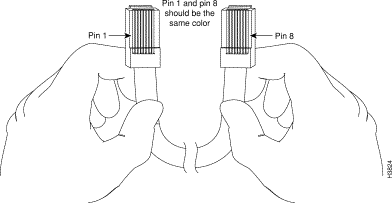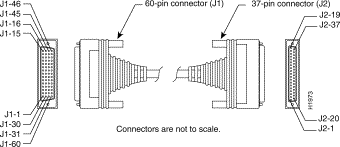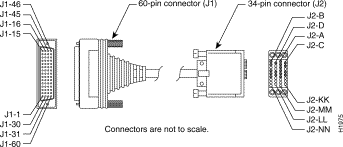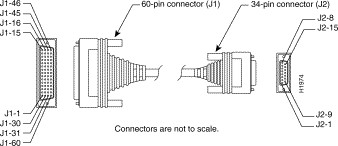|
|

This appendix provides the following pinout information:
The access server comes with a console and auxiliary cable kit that contains the cable and adapters you need to connect a console (an ASCII terminal or PC running terminal emulation software) or modem to your access server. The console and auxiliary cable kit includes the following items:
For console connections, proceed to the section "Console Port Signals and Pinouts" later in this appendix; for modem connections, proceed to the section "Auxiliary Port Signals and Pinouts" later in this appendix.
You can identify a rollover cable by comparing the two modular ends of the cable. Holding the cables side-by-side, with the tab at the back, the wire connected to the pin on the outside of the left plug should be the same color as the wire connected to the pin on the outside of the right plug. (See Figure C-1.) If your cable was purchased from Cisco Systems, pin 1 will be white on one connector, and pin 8 will be white on the other (a rollover cable reverses pins 1 and 8, 2 and 7, 3 and 6, and 4 and 5).

Use the RJ-45-to-RJ-45 rollover cable and RJ-45-to-DB-9 female DTE adapter (labeled Terminal) to connect the console port to a PC running terminal emulation software. Figure C-2 shows how to connect the console port to a PC. Table C-1 lists the pinouts for the asynchronous serial console port, the RJ-45-to-RJ-45 rollover cable, and the RJ-45-to-DB-9 female DTE adapter (labeled Terminal).

| Console Port (DTE) | RJ-45-to-RJ-45 Rollover Cable | RJ-45-to-DB-9 Terminal Adapter | Console Device | |
|---|---|---|---|---|
| Signal | RJ-45 Pin | RJ-45 Pin | DB-9 Pin | Signal |
RTS | 11 | 8 | 8 | CTS |
DTR | 2 | 7 | 6 | DSR |
TxD | 3 | 6 | 2 | RxD |
GND | 4 | 5 | 5 | GND |
GND | 5 | 4 | 5 | GND |
RxD | 6 | 3 | 3 | TxD |
DSR | 7 | 2 | 4 | DTR |
CTS | 81 | 1 | 7 | RTS |
| 1Pin 1 is connected internally to Pin 8. |
Use the RJ-45-to-RJ-45 rollover cable and RJ-45-to-DB-25 female DTE adapter (labeled Terminal) to connect the console port to a terminal. Figure C-3 shows how to connect the console port to a terminal. Table C-2 lists the pinouts for the asynchronous serial console port, the RJ-45-to-RJ-45 rollover cable, and the RJ-45-to-DB-25 female DTE adapter (labeled Terminal).

| Console Port (DTE)1 | RJ-45-to-RJ-45 Rollover Cable | RJ-45-to-DB-25 Terminal Adapter | Console Device | |
|---|---|---|---|---|
| Signal | RJ-45 Pin | RJ-45 Pin | DB-25 Pin | Signal |
RTS | 12 | 8 | 5 | CTS |
DTR | 2 | 7 | 6 | DSR |
TxD | 3 | 6 | 3 | RxD |
GND | 4 | 5 | 7 | GND |
GND | 5 | 4 | 7 | GND |
RxD | 6 | 3 | 2 | TxD |
DSR | 7 | 2 | 20 | DTR |
CTS | 81 | 1 | 4 | RTS |
| 1You can use the same cabling to connect a console to the auxiliary port. 2Pin 1 is connected internally to Pin 8. |
Use the RJ-45-to-RJ-45 rollover cable and RJ-45-to-DB-25 male DCE adapter (labeled Modem) to connect the auxiliary port to a modem. Figure C-4 shows how to connect the auxiliary port to a modem. Table C-3 lists the pinouts for the asynchronous serial auxiliary port, the RJ-45-to-RJ-45 rollover cable, and the RJ-45-to-DB-25 male DCE adapter (labeled Modem).

| AUX Port (DTE) | RJ-45-to-RJ-45 Rollover Cable | RJ-45-to-DB-25 Modem Adapter | Modem | |
|---|---|---|---|---|
| Signal | RJ-45 Pin | RJ-45 Pin | DB-25 Pin | Signal |
RTS | 1 | 8 | 4 | RTS |
DTR | 2 | 7 | 20 | DTR |
TxD | 3 | 6 | 3 | TxD |
GND | 4 | 5 | 7 | GND |
GND | 5 | 4 | 7 | GND |
RxD | 6 | 3 | 2 | RxD |
DSR | 7 | 2 | 8 | DCD |
CTS | 8 | 1 | 5 | CTS |
This section describes the pinouts for the Ethernet ports and cables.
Figure C-5 shows an Ethernet attachment unit interface (AUI) cable assembly, and Table C-4 lists the AUI cable pinouts.

| Pin | Ethernet Circuit | Signal |
|---|---|---|
3 | DO-A | Data Out Circuit A |
10 | DO-B | Data Out Circuit B |
11 | DO-S | Data Out Circuit Shield |
5 | DI-A | Data In Circuit A |
12 | DI-B | Data In Circuit B |
4 | DI-S | Data In Circuit Shield |
2 | CI-A | Control In Circuit A |
9 | CI-B | Control In Circuit B |
1 | CI-S | Control In Circuit Shield |
6 | VC | Voltage Common |
13 | VP | Voltage Plus |
14 | VS | Voltage Shield (L25 and M25) |
Shell | PG | Protective Ground |
Table C-5 lists the dual T1/PRI card port pinouts. Use a straight-through RJ-48C-to-RJ-48C cable to connect the T1 port to an RJ-48C jack.
| RJ-48C8 Pin1 | Description |
|---|---|
1 | Receive Ring from telco |
2 | Receive Tip from telco |
4 | Transmit Ring to telco |
5 | Transmit Tip to telco |
| 1Pins 3, 6, 7, and 8 are not used. |
Table C-6 lists the six serial cables available from Cisco Systems for connecting the E1 or T1/PRI card ports.
| Cable Description | Part Number | Product Number |
|---|---|---|
DB-15 to BNC | 72-0818-01 | CAB-E1-BNC |
DB-15 to DB-15 Null | 72-0838-01 | CAB-E1-DB15 |
DB-15 to Twinax | 72-0819-01 | CAB-E1-TWINAX |
DB-15 to RJ-48C | 72-0820-03 | CAB-E1-PRI/TE |
DB-15 to RJ-48C | 72-1255-01 | CAB-E1-PRI/NT |
RJ-48C to RJ-48C | 72-1181-01 | CAB-T1-PRI |
Five serial E1 cables are available from Cisco Systems for connecting the dual E1/PRI card ports. All five have DB-15 connectors on the E1 end and either BNC, DB-15, Twinax, or RJ-48C connectors on the network end. Figure C-6, Figure C-7, Figure C-8, and Figure C-9 show the E1 interface cables. Table C-7 lists the pinouts for the E1 interface cables connecting to the dual E1/PRI card.




| CE1 End | Network End | |||||||||
|---|---|---|---|---|---|---|---|---|---|---|
| DB-151 | BNC | DB-15 | Twinax | RJ-452 | RJ-45/NT3 | |||||
| Pin | Signal4 | Signal | Pin | Signal | Pin | Signal | Pin | Signal | Pin | Signal |
8 | RX Tip | TX Tip | 1 | TX Tip | TX-1 | TX Tip | 4 | RX Tip | 1 | TX Tip |
15 | RX Ring | TX Shield | 9 | TX Ring | TX-2 | TX Ring | 5 | RX Ring | 2 | TX Ring |
7 | RX Shield | - | 2 | TX Shield | Shield | TX Shield | 6 | RX Shield | 3 | TX Shield |
9 | TX Tip | RX Tip | 3 | RX Tip | RX-1 | RX Tip | 1 | TX Tip | 4 | RX Tip |
2 | TX Ring | RX Shield | 11 | RX Ring | RX-2 | RX Ring | 2 | TX Ring | 5 | RX Ring |
10 | TX Shield | - | 4 | RX Shield | Shield | RX Shield | 3 | TX Shield | 6 | RX Shield |
| 1Any pins not described in this table are not connected. 2Connected as a network interface. 3Connected as a network terminal. 4TX = transmit; RX = receive. |
The illustrations and tables in this section provide assembly drawings and pinouts for the EIA-530 data communications equipment (DCE), EIA/TIA-232, EIA/TIA-449, V.35, and X.21 DTE and DCE cables, which are used with the five-in-one synchronous serial WAN port.
Figure C-10 shows the EIA-530 serial cable assembly, and Table C-8 lists the pinouts. Arrows indicate signal direction: a right arrow (—>) indicates DTE to DCE, and a left arrow (<—) indicates DCE to DTE.

60 Pin | Signal | 25 Pin | Signal | Direction DTE DCE1 |
|---|---|---|---|---|
J1-11 | TxD/RxD+ | J2-2 | BA(A), TxD+ | —> |
J1-28 | RxD/TxD+ | J2-3 | BB(A), RxD+ | <— |
J1-9 | RTS/CTS+ | J2-4 | CA(A), RTS+ | —> |
J1-1 | CTS/RTS+ | J2-5 | CB(A), CTS+ | <— |
J1-3 | DSR/DTR+ | J2-6 | CC(A), DSR+ | <— |
J1-46 | Shield_GND | J2-1 | Shield | Shorted |
J1-48 | GND | - | - | Shorted |
J1-5 | DCD/DCD+ | J2-8 | CF(A), DCD+ | <— |
J1-24 | TxC/RxC+ | J2-15 | DB(A), TxC+ | <— |
J1-26 | RxC/TxCE+ | J2-17 | DD(A), RxC+ | <— |
J1-44 | LL/DCD | J2-18 | LL | —> |
J1-7 | DTR/DSR+ | J2-20 | CD(A), DTR+ | —> |
J1-13 | TxCE/TxC+ | J2-24 | DA(A), TxCE+ | —> |
| 1The EIA-530 interface cannot be operated in DCE mode. A DCE cable is not available for the EIA-530 interface. |
Figure C-11 shows the EIA/TIA-232 cable assembly. Table C-9 lists the DTE pinouts. Table C-10 lists the DCE pinouts. Arrows indicate signal direction: a right arrow (—>) indicates DTE to DCE, and a left arrow (<—) indicates DCE to DTE.

| 60 Pin | Signal | Description | Direction | 25 Pin | Signal |
|---|---|---|---|---|---|
J1-50 | MODE_0 | Shorting group | - | - | - |
J1-46 | Shield GND | Single | - | J2-1 | Shield GND |
J1-41 | TxD/RxD | Twisted pair no. 5 | —> | J2-2 | TxD |
J1-36 | RxD/TxD | Twisted pair no. 9 | <— | J2-3 | RxD |
J1-42 | RTS/CTS | Twisted pair no. 4 | —> | J2-4 | RTS |
J1-35 | CTS/RTS | Twisted pair no. 10 | <— | J2-5 | CTS |
J1-34 | DSR/DTR | Twisted pair no. 11 | <— | J2-6 | DSR |
J1-45 | Circuit GND | Twisted pair no. 1 | - | J2-7 | Circuit GND |
J1-33 | DCD/LL | Twisted pair no. 12 | <— | J2-8 | DCD |
J1-37 | TxC/NIL | Twisted pair no. 8 | <— | J2-15 | TxC |
J1-38 | RxC/TxCE | Twisted pair no. 7 | <— | J2-17 | RxC |
J1-44 | LL/DCD | Twisted pair no. 2 | —> | J2-18 | LTST |
J1-43 | DTR/DSR | Twisted pair no. 3 | —> | J2-20 | DTR |
J1-39 | TxCE/TxC | Twisted pair no. 6 | —> | J2-24 | TxCE |
| 60 Pin | Signal | Description | Direction | 25 Pin | Signal |
|---|---|---|---|---|---|
J1-50 | MODE_0 | Shorting group | - | - | - |
J1-46 | Shield GND | Single | - | J2-1 | Shield GND |
J1-36 | RxD/TxD | Twisted pair no. 9 | <— | J2-2 | TxD |
J1-41 | TxD/RxD | Twisted pair no. 5 | —> | J2-3 | RxD |
J1-35 | CTS/RTS | Twisted pair no. 10 | <— | J2-4 | RTS |
J1-42 | RTS/CTS | Twisted pair no. 4 | —> | J2-5 | CTS |
J1-43 | DTR/DSR | Twisted pair no. 3 | —> | J2-6 | DSR |
J1-45 | Circuit GND | Twisted pair no. 1 | - | J2-7 | Circuit GND |
J1-44 | LL/DCD | Twisted pair no. 2 | —> | J2-8 | DCD |
J1-39 | TxCE/TxC | Twisted pair no. 7 | —> | J2-15 | TxC |
J1-40 | NIL/RxC | Twisted pair no. 6 | —> | J2-17 | RxC |
J1-33 | DCD/LL | Twisted pair no. 12 | <— | J2-18 | LTST |
J1-34 | DSR/DTR | Twisted pair no. 11 | <— | J2-20 | DTR |
J1-38 | RxC/TxCE | Twisted pair no. 8 | <— | J2-24 | TxCE |
Figure C-12 shows the EIA/TIA-449 cable assembly. Table C-11 lists the DTE pinouts. Table C-12 lists the DCE pinouts. Arrows indicate signal direction: a right arrow (—>) indicates DTE to DCE, and a left arrow (<—) indicates DCE to DTE.

| 60 Pin | Signal | Description | Direction | 37 Pin | Signal |
|---|---|---|---|---|---|
J1-49 | MODE_1 | Shorting group | - | - | - |
J1-51 | GND | Shorting group | - | - | - |
J1-46 | Shield_GND | Single | _ | J2-1 | Shield GND |
J1-11 | TxD/RxD+ | Twisted pair no. 6 | —> | J2-4 | SD+ |
J1-24 | TxC/RxC+ | Twisted pair no. 9 | <— | J2-5 | ST+ |
J1-28 | RxD/TxD+ | Twisted pair no. 11 | <— | J2-6 | RD+ |
J1-9 | RTS/CTS+ | Twisted pair no. 5 | —> | J2-7 | RS+ |
J1-26 | RxC/TxCE+ | Twisted pair no. 10 | <— | J2-8 | RT+ |
J1-1 | CTS/RTS+ | Twisted pair no. 1 | <— | J2-9 | CS+ |
J1-44 | LL/DCD | Twisted pair no. 12 | —> | J2-10 | LL |
J1-3 | DSR/DTR+ | Twisted pair no. 2 | <— | J2-11 | DM+ |
J1-7 | DTR/DSR+ | Twisted pair no. 4 | —> | J2-12 | TR+ |
J1-5 | DCD/DCD+ | Twisted pair no. 3 | <— | J2-13 | RR+ |
J1-13 | TxCE/TxC+ | Twisted pair no. 7 | —> | J2-17 | TT+ |
J1-15 | Circuit_GND | Twisted pair no. 9 | - | J2-19 | SG |
| 60 Pin | Signal | Description | Direction | 37 Pin | Signal |
|---|---|---|---|---|---|
J1-49 | MODE_1 | Shorting group | - | - | - |
J1-46 | Shield_GND | Single | - | J2-1 | Shield GND |
J1-28 | RxD/TxD+ | Twisted pair no. 11 | <— | J2-4 | SD+ |
J1-13 | TxCE/TxC+ | Twisted pair no. 7 | —> | J2-5 | ST+ |
J1-11 | TxD/RxD+ | Twisted pair no. 6 | —> | J2-6 | RD+ |
J1-1 | CTS/RTS+ | Twisted pair no. 1 | <— | J2-7 | RS+ |
J1-24 | TxC/RxC+ | Twisted pair no. 9 | —> | J2-8 | RT+ |
J1-9 | RTS/CTS+ | Twisted pair no. 5 | —> | J2-9 | CS+ |
J1-29 | NIL/LL | Twisted pair no. 12 | —> | J2-10 | LL |
J1-7 | DTR/DSR+ | Twisted pair no. 4 | —> | J2-11 | DM+ |
J1-3 | DSR/DTR+ | Twisted pair no. 2 | <— | J2-12 | TR+ |
J1-5 | DCD/DCD+ | Twisted pair no. 3 | —> | J2-13 | RR+ |
J1-26 | RxC/TxCE+ | Twisted pair no. 10 | <— | J2-17 | TT+ |
J1-15 | Circuit_GND | Twisted pair no. 8 | _ | J2-19 | SG |
Figure C-13 shows the V.35 cable assembly. Table C-13 lists the DTE pinouts. Table C-14 lists the DCE pinouts. Arrows indicate signal direction: a right arrow (—>) indicates DTE to DCE, and a left arrow (<—) indicates DCE to DTE.

| 60 Pin | Signal | Description | Direction | 34 Pin | Signal |
|---|---|---|---|---|---|
J1-49 | MODE_1 | Shorting group | - | - | - |
J1-50 | MODE_0 | Shorting group | - | - | - |
J1-53 | TxC/NIL | Shorting group | - | - | - |
J1-46 | Shield_GND | Single | - | J2-A | Frame GND |
J1-45 | Circuit_GND | Twisted pair no. 12 | - | J2-B | Circuit GND |
J1-42 | RTS/CTS | Twisted pair no. 9 | —> | J2-C | RTS |
J1-35 | CTS/RTS | Twisted pair no. 8 | <— | J2-D | CTS |
J1-34 | DSR/DTR | Twisted pair no. 7 | <— | J2-E | DSR |
J1-33 | DCD/LL | Twisted pair no. 6 | <— | J2-F | RLSD |
J1-43 | DTR/DSR | Twisted pair no. 10 | —> | J2-H | DTR |
J1-44 | LL/DCD | Twisted pair no. 11 | —> | J2-K | LT |
J1-18 | TxD/RxD+ | Twisted pair no. 1 | —> | J2-P | SD+ |
J1-28 | RxD/TxD+ | Twisted pair no. 5 | <— | J2-R | RD+ |
J1-20 | TxCE/TxC+ | Twisted pair no. 2 | —> | J2-U | SCTE+ |
J1-26 | RxC/TxCE+ | Twisted pair no. 4 | <— | J2-V | SCR+ |
J1-24 | TxC/RxC+ | Twisted pair no. 3 | <— | J2-Y | SCT+ |
| 60 Pin | Signal | Description | Direction | 34 Pin | Signal |
|---|---|---|---|---|---|
J1-49 | MODE_1 | Shorting group | - | - | - |
J1-50 | MODE_0 | Shorting group | - | - | - |
J1-53 | TxC/NIL | Shorting group | - | - | - |
J1-46 | Shield_GND | Single | - | J2-A | Frame GND |
J1-45 | Circuit_GND | Twisted pair no. 12 | - | J2-B | Circuit GND |
J1-35 | CTS/RTS | Twisted pair no. 8 | <— | J2-C | RTS |
J1-42 | RTS/CTS | Twisted pair no. 9 | —> | J2-D | CTS |
J1-43 | DTR/DSR | Twisted pair no. 10 | —> | J2-E | DSR |
J1-44 | LL/DCD | Twisted pair no. 11 | —> | J2-F | RLSD |
J1-34 | DSR/DTR | Twisted pair no. 7 | <— | J2-H | DTR |
J1-33 | DCD/LL | Twisted pair no. 6 | <— | J2-K | LT |
J1-28 | RxD/TxD+ | Twisted pair no. 5 | <— | J2-P | SD+ |
J1-18 | TxD/RxD+ | Twisted pair no. 1 | —> | J2-R | RD+ |
J1-26 | RxC/TxCE+ | Twisted pair no. 4 | <— | J2-U | SCTE+ |
J1-22 | NIL/RxC+ | Twisted pair no. 3 | —> | J2-V | SCR+ |
J1-20 | TxCE/TxC+ | Twisted pair no. 2 | —> | J2-Y | SCT+ |
Figure C-14 shows the X.21 cable assembly. Table C-15 lists the DTE pinouts. Table C-16 lists the DCE pinouts. Arrows indicate signal direction: a right arrow (—>) indicates DTE to DCE, and a left arrow (<—) indicates DCE to DTE.

| 60 Pin | Signal | Description | Direction | 15 Pin | Signal |
|---|---|---|---|---|---|
J1-48 | GND | Shorting group | - | - | - |
J1-51 | GND | Shorting group | - | - | - |
J1-46 | Shield_GND | Single | - | J2-1 | Shield GND |
J1-11 | TxD/RxD+ | Twisted pair no. 3 | —> | J2-2 | Transmit+ |
J1-9 | RTS/CTS+ | Twisted pair no. 2 | —> | J2-3 | Control+ |
J1-28 | RxD/TxD+ | Twisted pair no. 6 | <— | J2-4 | Receive+ |
J1-1 | CTS/RTS+ | Twisted pair no. 1 | <— | J2-5 | Indication+ |
J1-26 | RxC/TxCE+ | Twisted pair no. 5 | <— | J2-6 | Timing+ |
J1-15 | Control_GND | Twisted pair no. 4 | - | J2-8 | Control GND |
| 60 Pin | Signal | Description | Direction | 15 Pin | Signal |
|---|---|---|---|---|---|
J1-48 | GND | Shorting group | - | - | - |
J1-46 | Shield_GND | Single | - | J2-1 | Shield GND |
J1-28 | RxD/TxD+ | Twisted pair no. 6 | <— | J2-2 | Transmit+ |
J1-1 | CTS/RTS+ | Twisted pair no. 1 | <— | J2-3 | Control+ |
J1-11 | TxD/RxD+ | Twisted pair no. 3 | —> | J2-4 | Receive+ |
J1-9 | RTS/CTS+ | Twisted pair no. 2 | —> | J2-5 | Indication+ |
J1-24 | TxC/RxC+ | Twisted pair no. 4 | —> | J2-6 | Timing+ |
J1-15 | Control_GND | Twisted pair no. 5 | - | J2-8 | Control GND |
Table C-17 lists the pinouts for the alarm port.
| Pin | Description |
|---|---|
1 | Normally open |
2 | Common |
3 | Normally closed |
![]()
![]()
![]()
![]()
![]()
![]()
![]()
![]()
Posted: Fri Jun 7 10:38:25 PDT 2002
All contents are Copyright © 1992--2002 Cisco Systems, Inc. All rights reserved.
Important Notices and Privacy Statement.